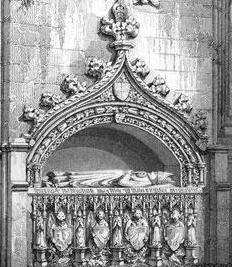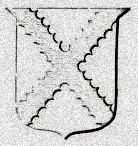Related Research Articles

Robert de Cardeny was a late 14th and early 15th century Scottish cleric. He was the son of one John Cardeny, and brother of the royal mistress Mariota de Cardeny. His early career is obscure. In 1378–80, King Robert II of Scotland petitioned the Pope for a canonry in the diocese of Moray for one Robert de Cardun, despite the fact that the latter already held canonries and prebends in the diocese of Dunblane and Dunkeld. This Robert de Cardun was both a member of King Robert's household and a student at the University of Paris. Robert had graduated from Paris in 1381 as Licentiate. In 1392 he was a receiver of the "English Nation" at Paris and custodian of the Nation's seal. In 1394 Robert was still in Paris, now as Master Robert de Cardeny
George Brown was a late 15th-century and early 16th-century Scottish churchman. He first appears on record in 1478 as the rector of the church of Tyningham, and is called a clerk of the diocese of Brechin. In 1482, he was selected to be Chancellor of the diocese of Aberdeen.
Donald Campbell was a 16th-century Scottish noble and churchman. He was the son of Archibald Campbell, 2nd Earl of Argyll and Elizabeth Stewart, daughter of John Stewart, 1st Earl of Lennox. From 1522, he was a student of St Salvator's College, at the University of St Andrews. After graduation, he became a cleric in his home diocese, the diocese of Argyll.

John de Innes was medieval Scottish churchman. Born probably in Moray, he went to France in his youth, receiving a bachelorate in civil law from the University of Paris by 1396 and in canon law by 1407. His education was partly paid for by the prebend of Duffus and a grant from Alexander Bur, Bishop of Moray, taken by Bur from the judicial profits of his diocese. During Innes' study period, he was also pursuing an ecclesiastical career, being Archdeacon of Caithness from 1396 until 1398, and Dean of Ross, from some point between 1396 and 1398 until 1407.
Thomas de Rossy O. F. M. was a late 14th century Scottish Franciscan friar, papal penitentiary, bishop and theologian. Of unknown, or at least unclear origin, he embarked on a religious career in his early years, entering the Franciscan Order, studying in England and at the University of Paris.
Ingram de Ketenis was a medieval cleric from Angus in Scotland.
Ninian Spot [de Spot] was a royal clerk and prelate in the 15th century Kingdom of Scotland. He spent much of his youth at university, eventually obtaining Master's Degree.
Alexander de Waghorn, Bishop of Ross, bears a surname that may suggest an origin in the Glasgow area of southern Scotland, though there are other possibilities.
Alexander de Kylwos – written alternatively as Frylquhous, Kylquos, and a variety of other forms – was a Scottish churchman and prelate active in the second half of the 14th century. He is known to have held senior positions in three bishoprics, and senior offices in two, before being elected and appointed Bishop of Ross in 1371. Though his episcopate is relatively obscure, he seems to have spent almost all of it inside or around his province, was closely associated with William III and Euphemia I, successive rulers of Ross, and was an associate of the famous Alexander Bur, Bishop of Moray, during the latter's struggle with Alexander Stewart, the son of the King later known by the nickname "Wolf of Badenoch".

Albin was a 13th-century prelate of the Kingdom of Scotland. A university graduate, Albin is known for his ecclesiastical career in the diocese of Brechin, centred on Angus in east-central Scotland.
Patrick de Leuchars [also de Locrys or de Lochrys] was a 14th-century administrator and prelate in the Kingdom of Scotland. He first appears in the records in 1344 holding a church in East Lothian, and in 1351 attains national prominence as the new Bishop of Brechin. Bishop Patrick, who would be a core supporter of King David II of Scotland, became Royal Chancellor in the same decade. He held the chancellorship until around 1370, and the bishopric of Brechin until 1383, when he resigned it on account of his old age.
Dúghall of Lorne [or de Ergadia] was a late 14th century and early 15th century prelate in the Kingdom of Scotland. Probably a MacDúghaill (MacDougall) from the province of Lorne in Argyll, he appears to have studied at the University of Oxford before returning to Scotland for an ecclesiastical and administrative career. He obtained benefices in the diocese of Argyll, Dunkeld, Dunblane and St Andrews, and acted as the secretary and chaplain of Robert Stewart, Earl of Fife, before becoming Bishop of Dunblane. He held the bishopric of Dunblane until his death in 1403.

Nicholas de Balmyle, also called Nicholas of St Andrews, was a Scottish administrator and prelate in the late 13th century and early 14th century. A graduate of an unknown university, he served his earliest years as a clergyman at St Andrews, moving on to hold churches in Lothian as well as deputising to two archdeacons of Lothian.
William de Cambuslang was a 14th-century Scottish churchman, presumably coming from a family based at or originating from Cambuslang near Glasgow.
John Spalding was a 15th-century churchman based at Brechin in Angus, Scotland. Spalding became Dean of Brechin in 1456; he was confirmed in this position by the Pope on 5 October 1458.
The Archdeacon of Brechin was the only archdeacon in the diocese of Brechin, acting as a subordinate of the Bishop of Brechin. The archdeacon held the parish church of Strachan as a prebend from at least 1274.

William de Crachin was a prelate active in the Kingdom of Scotland in the 13th century. The earliest known Dean of Brechin Cathedral, his first appearance in a surviving source comes 22 September 1248, from a document of Arbroath Abbey.
Nicholas was a Scottish churchman and prelate active at the end of the 13th century. While holding the office of sub-dean of Brechin Cathedral, he got provided bishop of Brechin by Pope Boniface VIII on 21 January 1297.
George Shoreswood or Schoriswood, was a prelate active in the Kingdom of Scotland during the 15th century. He appears to have been of English-speaking origin, from the family of Bedshiel in Berwickshire.
John de Crannach was a 15th-century Scottish scholar, diplomat and prelate. Originating in the north-east of Lowland Scotland, he probably came from a family associated with the burgh of Aberdeen. Like many of his relatives, he flourished in the 15th-century Scottish church. After just over a decade at the University of Paris, Crannach became a servant of the then Dauphin Charles (VII).
References
- Dowden, John (1912), Thomson, John Maitland (ed.), The Bishops of Scotland : Being Notes on the Lives of All the Bishops, under Each of the Sees, Prior to the Reformation, Glasgow: James Maclehose and Sons
- Ewan, Elizabeth (2004), "Forrester family (per. c.1360–c.1450)", Oxford Dictionary of National Biography , retrieved 26 September 2010
- Watt, D. E. R. (1977), A Biographical Dictionary of Scottish Graduates to A.D. 1410 , Oxford: Clarendon Press, ISBN 0-19-822447-8
- Watt, D. E. R.; Murray, A. L., eds. (2003), Fasti Ecclesiae Scotinanae Medii Aevi ad annum 1638, The Scottish Record Society, New Series, Volume 25 (Revised ed.), Edinburgh: The Scottish Record Society, ISBN 0-902054-19-8, ISSN 0143-9448